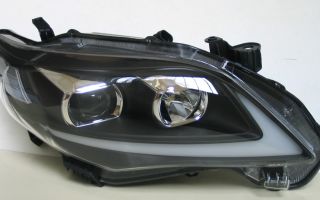Comparative test of headlights: LEDs, halogen, xenon - magazine Behind the Wheel
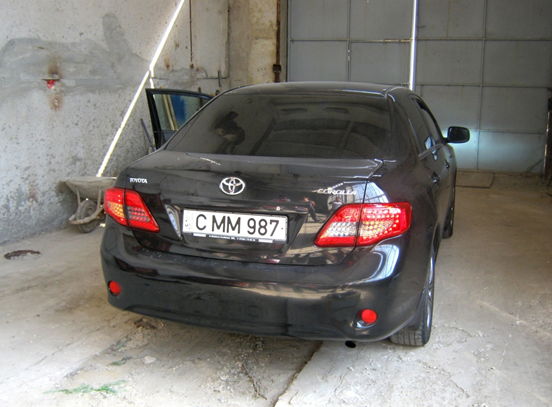
From left to right: Mazda 6 with bi-xenon cornering headlights; Mazda 6 with full LED adaptive headlights; Nissan Tiida Tekna with LED low beam and halogen high beam; Nissan Tiida Elegance with separate halogen lights - low and high.
Related materials
At first, LED headlights were reserved only for cars of premium brands, but over the past year or two, new technology has made a breakthrough and began to displace xenon light from the list of additional options even on cars in the mid-price range. Is it deserved?
To check this, we equipped four cars for a night test at the Dmitrovsky test site. The first pair are Nissan Tiida hatchbacks: one with halogen headlights and the other with LED headlights. Moreover, the LEDs are non-adaptive and are used only in low beam.
And also two Mazda 6 sedans. After the recent restyling, the “six” replaced the bi-xenon headlights with fully adaptive LED ones. Therefore, we took a new car and a pre-reform one: let’s see if there is progress.
BRIGHT FUTURE?
If the luminous flux encounters some surface on its path, then it receives illumination, measured in lux (lx). We took with us the Ecolight luminometer SFAT.412125.
002 and measured illumination at different distances on a 200-meter test section of the road. In addition to the measurements, the results of which are summarized in a table, photographs taken from one angle will help you evaluate the light distribution.
After all, no numbers can convey what the eyes see.
The first to approach the 200-meter “line” of cones with reflectors is the most modest test participant - Tiida with halogen light. It showed the expected and not outstanding result: a spot of warm yellow color loses a person dressed in dark clothes on the right side of the road already at a distance of 50 meters with low beam, and when switching to high beam - at a distance of 120 meters. This is our starting point.
Tiida comes to the starting position in an expensive configuration: the LEDs flash white and... Silent scene.
New-fashioned LEDs shine along the strip for only 25 meters! Moreover, due to the specific shape of the beam, a pedestrian in dark clothes is visible on the side of the road in the LED low beam at a distance of 40 meters.
The loss to halogens is not so great, since the LED beam “shoots” the roadside better, but still a loss! It’s time to remember the dawn of motorization, when a man with a red flag walked in front of the car and warned of the approach of an unprecedented self-propelled carriage.
NISSAN TIIDA, HALOGEN LOW BEAM
NISSAN TIIDA, HALOGEN LOW BEAM
Related materials
The Mazda 6 with bi-xenon optics immediately made it clear that our 200-meter “line” would not be enough for it. Near the last mark, the device detected lux even from the low beam headlights, and the high beam even illuminated the forest 320 meters from the car. The “targeted” pedestrian disappeared from view at a distance of 60 meters in low beam mode and 120 meters in high beam mode.
And the LED headlights puzzled me again.
The picture is not as catastrophic as Tiida’s, but similar: the border of light and shadow is noticeably closer than in the case of xenon, and the nearest part is exactly in the traffic lane, and the side of the road is better illuminated.
An experiment with a person confirmed the first impressions: the visibility limits of a pedestrian dressed in black are 55 and 110 meters, which is worse than xenon. So much for new technologies.
EH, I'LL ROCK IT!
Let’s back up the measurements with subjective driving sensations.
In the case of Tiids, the halogen lights do a good job of their task and allow you to move quite comfortably at speeds allowed outside the city.
But driving with LED headlights is unpleasant and sometimes even dangerous, primarily due to the strange light distribution.
The LEDs hit hard along the right side of the road and slightly cover the oncoming lane, but right in front of the nose they cut out a rather significant piece from the light beam - probably so as not to blind the driver of the car in front.
Caring for your neighbor is a good thing, but not at the expense of yourself! You don't always follow someone.
NISSAN TIIDA, LED LOW BEAM
NISSAN TIIDA, LED LOW BEAM
Related materials
Moreover, the boundary of light and shadow is very sharp and it is impossible to see anything beyond it - as if a curtain had been lowered in front of the car, and 25 meters from the bumper. With such a modest range, to put it mildly, other advantages of LEDs (for example, the color of the light beam that is more familiar to the eye) come to naught.
The boundaries of the light zone expand significantly when you switch to high beam - more precisely, additional sections with a halogen lamp light up. But you won’t be able to keep it on all the time—you’ll blind those you meet.
In addition, the two-color beam (white from LEDs and yellow from halogens) quickly tires the eyes.
But even on Mazda, not everything is clear! At low speeds, LED low beam is also inferior to xenon, although the electronics can adjust the shape of the light beam depending on the road situation.
You only feel the benefit of the intelligent control system at speeds above 40 km/h and when there are no other cars in sight: the high beams automatically turn on, immediately stopping all talk about insufficient efficiency.
Related materials
When passing or oncoming cars approach, the LED headlight does not turn off the high beam completely, but only dims individual sections so as not to dazzle other drivers - it’s as if a dark rectangle is cut out in the beam of light, in which the oncoming car looms.
Based on data from the front camera, the electronics plays with the shape of the beam quite clearly. Only in a couple of cases did she mistakenly dim the lights, mistaking a bright flashlight for the headlights of an oncoming car.
The xenon headlights of the pre-reform Mazda shine better, but they do not know how to dim the light, and therefore when passing oncoming traffic and overtaking you have to manually switch from high beam to low beam and back. That is why, with slightly worse light source parameters, we rate the LED headlights of the updated Mazda 6 higher than the old, gas-discharge lamps.
Both Mazda lighting equipment can “look” into turns, but we did not notice any significant difference in the clarity and speed of response either on the special roads of the test site or on public roads.
MAZDA 6, XENON LOW BEAM
MAZDA 6, XENON LOW BEAM
The conclusion is ambiguous: I simultaneously vote for LEDs and against them. Obviously, on inexpensive cars without electronic control of the shape and brightness of the light beam, LED headlights are inferior to standard halogen ones.
In the case of Tiida, the overpayment for cool LEDs seems to be modest: for 27 thousand rubles you get advanced headlights, curtain airbags, cruise control and a couple of other decorative little things. But - what a paradox! - you get worse light.
And on cars in the middle and higher price segments, smart adaptive headlights not only skillfully hide the shortcomings of semiconductor light sources, but also make night trips safer. We have seen this before on other expensive cars. And for this alone it is worth joining high technology.
They are not cheap yet, but the option itself when buying a new car is priced approximately the same as the “old” xenon.
MAZDA 6, LED LOW BEAM
MAZDA 6, LED LOW BEAM
For example, for Mazda it’s 170 thousand rubles for a package of LED headlights, leather interior with electric drives and adjustment memory, head-up display and heated rear seats. A year ago, with a much more humane exchange rate, a similar set with bi-xenon (by the way, without a head-up display and heated rear seats) cost 130 thousand rubles.
When purchasing optics separately, the difference is more noticeable: a xenon headlight for a “six” costs about 40 thousand rubles (for reference: a more sophisticated one on an Audi A8 will cost 100 thousand), and an LED headlight is at least twice as expensive, and there are no non-original components and, most likely, not will. Such price tags can lead to a heart attack. However, LED technology will quickly become cheaper.
And the future lies with these light sources - this is clear today.
Let's adapt
(1)
(1)
The future belongs to multifunctional headlights that automatically form a light beam depending on speed, weather conditions, road profile and the presence of other cars. A set of devices is responsible for the distribution of light: sensors for rain, speed, steering angle and suspension position, a camera on the windshield, and a navigation system.
The first effectively working adaptive lighting technology (1) was made on the basis of bi-xenon headlights. A curtain drum installed between the lamp and the lens is responsible for changing the light distribution in them.
Rotating on a horizontal axis, it occupies one of several fixed positions, each of which forms a light beam. This is how urban, suburban, highway and other lighting options are obtained.
Later, engineers decided to use mainly high beams and combat glare by gradually lowering the lamps.
(2)
(2)
(2) LED technology has opened new horizons. The headlight (2) has several LEDs, each of which is responsible for its own road segment. This means that you can shade individual sectors, leaving the rest of the space illuminated.
The most advanced, complex and expensive are the so-called matrix headlights (3). Each light source, numbering in the dozens, is responsible for a specific sector.
The headlight does not have rotating elements to regulate the light beam - the LEDs are rigidly fixed on a stationary board at certain angles relative to the horizontal and vertical axes, and the algorithms for turning on and adjusting the brightness are set by the program.
Since LEDs quickly fail at elevated temperatures, the headlights must have a forced cooling system - with microfans and additional air ducts for precise distribution of air flows.
(3)
(3)
Which headlights are better: LEDs, halogens or xenon?
Error in the text? Select it with your mouse! And press: Ctrl + Enter
Source: https://www.zr.ru/content/articles/819054-kakie-fary-luchshe-svetodiody-galogenki-ili-ksenon/
Bi-xenon and “angel eyes”: safety or tuning?
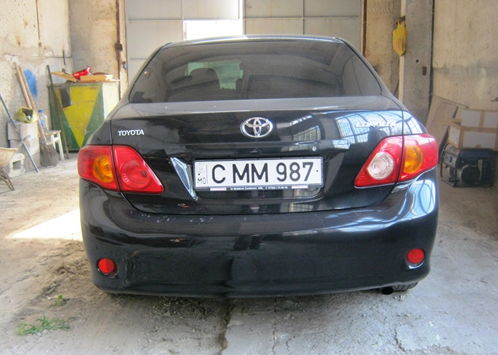
Bi-xenon modules, which have come into use among modern motorists, have been able to establish themselves as the most correct sources of light flux distribution in both low- and high-range lighting modes. Reflective optics with halogens are gradually becoming a thing of the past...
And for starters, it should be mentioned that bi-xenon lenses today have the clearest cut-off line that focuses the light beam as correctly as possible.
Not only your own safety, but also the safety of other road users depends on this.
After all, headlights should provide the driver with brightness, range and the largest area of illumination, but at the same time not “block” the driver’s visibility of an oncoming car with their blinding properties.
Of course, more advanced optics have already appeared, all kinds of matrix and laser ones, but they are so far available only on a few models of premium-segment cars. We largely consider the advantages of bi-xenon against the backdrop of halogens, which are slowly but surely becoming obsolete. There is no point in talking about lamps with incandescent filaments.
Let's take as an example a set of bi-xenon lenses Sho-Me KIT-230 (the brand has proven itself quite well in the domestic market, and in our hands is one of the latest new products of this season).
The module is a xenon lamp (color temperature 5000 Kelvin) coupled with a focusing lens and a light beam reflector. The simple principle of its operation is as follows.
An electromagnetic metal curtain that switches the light in the lens, in the closed position, contributes to the dispersion of the light flux, that is, it creates the greatest efficiency of glow from a small area, which forms the so-called low beam.
And in the open state, the light output performs the function of a directional action, in other words, it “hits” in a straight line and with maximum range. In other words, this is high beam. The change in focal length and direction of the beam is due to the use of a reflector and the so-called floating bulb.
Unlike the same gas-filled halogens, which are often used by motorists as a cheap alternative to xenon, such optics, as already mentioned, provide the greatest glow efficiency.
Not least thanks to the optimally configured light transmission boundary - it’s not for nothing that car builders began to massively switch to xenon lighting technology, including it in the list of standard equipment. But lovers of bells and whistles and various kinds of garage tuning will probably not pay attention to these lines.
In their opinion, it will not work to be sophisticated here, as with halogens, experimenting with different color options. But in vain, how will it work out!
Undoubtedly, the xenon lens, as in the case of the Sho-Me KIT-230, cannot shine in shades of red, blue or green, which is what the owners of old sports “Japs” and stuffed “cans” so much like to show off “among their own”, but but there is a much more progressive thing here - a neon ring. Or, as tuners also call it, “angel’s eye.”
It functions as an ambient light, attracting attention with a pleasant bluish flicker. And when the headlight is fully lit, this round luminous edging gives the car a completely unique appearance. In short, bright, aesthetic and fashionable.
With all this, it is also legal, while the use of the vast majority of lamps of other colors is contrary to traffic regulations.
And finally about the installation. The manufacturer strongly recommends installing lens modules in specialized service centers. However, installing lenses yourself is not a difficult task.
Perhaps the only thing that may cause difficulties is removing the headlight from the housing cap, which has an adhesive connection. To soften it, the entire “lamp” needs to be heated, and this is not easy to do in a garage environment.
Otherwise, no problems: we release the headlight from the standard fasteners, place the lens inside using the fixing ring and connect the plastic connectors. Then we secure the flashlight with screws and insert the lamp into the reflector. After completing these procedures, you will need to re-glue the transparent cap to the body.
An illustrated brochure to help. It also doubles as a warranty card. By the way, the promised service life of Sho-Me KIT-320 bi-xenon lights is more than 25,000 hours.
Vyacheslav Vasilenko, AutoVzglyad
Source: http://autooboz.info/2014/10/biksenon-i-angelskie-glazki-bezopasnost-ili-tyuning/
Upgrade of optics – Toyota Corolla
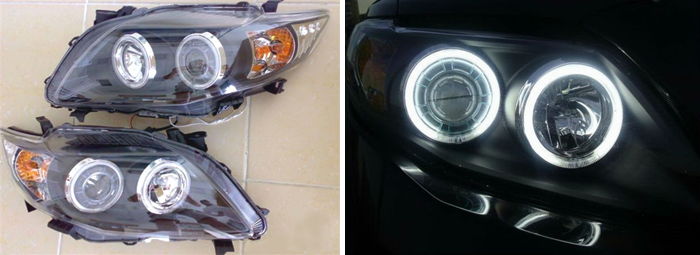
Toyota Corolla, Installation of Bi-xenon lenses
Description
Headlight units - Original
Installed Bi-xenon lenses (modules) Hella 2 Classic Matte
Base: D1S, D2S, D3S, D4S
Lens diameter: 3 inches
Country of origin: Germany
Xenon:
Xenon ignition units D1S OSRAM lamps
Toyota Corolla, Installation of Bi-xenon lenses
Description
Headlight units - Original
Installed Bi-xenon lenses (modules) HELLA Intemo
Base: D1S, D2S, D3S, D4S
Lens diameter: 3 inches
Country of origin: Germany
Light:
2 low +4 high
Xenon:
Ignition units Hella 3 D2S/D2R
Xenon lamps D2S Philips 85122+
Mask:
Option No. 15
Additionally:
DRLs installed in the bumper, model EGO Light DRL-100P18
Toyota Corolla Levin, Installation of Bi-xenon lenses
Description:
Headlight units - Original
Installed Bi-xenon lenses (modules) Hella
Base: D1S D2S D3S D4
Lens diameter: 3.0 inches
Country of origin: Germany
Xenon:
Ignition unit (ballast) Valeo Velarc 6G D1S
Xenon lamp D1S Philips
Additionally:
1. The glass where the lens is installed has been polished.
2. Polishing the outside of the headlights
3. Armoring the headlights with polyurethane film
4. Painting the worn out trim on the glass.
5. Marking for xenon DCR is applied to the headlight housing (hot stamping)
6. The yellow PTF cap is removed
Toyota Corolla, Installation of Morimoto H1 Bi-xenon lenses
About lenses:
Installed Morimoto H1 Bi-xenon lenses (modules)
Updated lens model.
Base: H1
Lens diameter: 3.0 inches
Country of origin: China
Description
Headlight units – Original Koito
1. Thermal sealant (disassembled by heating)
2. Mounting the lens on studs
3.
The wiring is standard and modified.
____________________________________________________________________________________
If you have any questions, you can call us at tel. or write to us by E-mail Contacts
https://www.youtube.com/watch?v=VuGYV4yeHkk
By installing headlights produced by Tuning40 you get:
1 - Improved light quality - increases comfortable driving speed;
2 — Increased safety at night by lighting not only your lane, but also the entire road surface, as well as roadsides and exits, pedestrians are better visible.
3 - Anti-fog guarantee and installed materials.
Source: http://tuning40.ru/modernizaciya-optiki/150
Fines for angel eyes
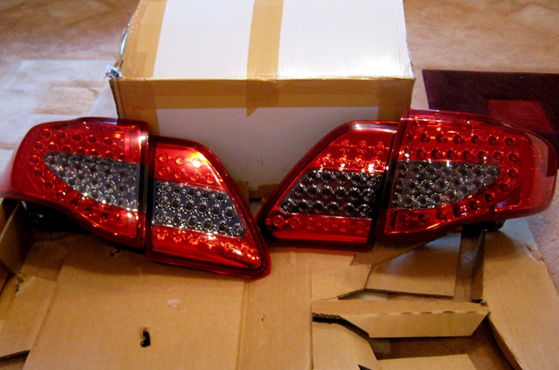
| Angel eyes have long been a popular fixture in the automotive lighting industry. The current situation shows that more and more drivers prefer installing this type of device as additional lighting. But the question of legalizing the use of angel eyes immediately arises. Of course, if you purchased a car with standard eyes, then you have nothing to fear, since the manufacturer produces cars with such optics legally, therefore, the eyes will not become a problem either. But what to do when you have installed or are just about to install angel eyes yourself? |
There is no specific law in the rules and regulations that deals with angel eyes. But there is a regulation according to which the driver has the right to use white lighting on the front of the car. Consequently, angel eyes that differ in the color of the glow (for example, red) are not allowed for use.
These include angel eyes with the following colors:
|
White angel eyes are allowed. How you installed them, whether you changed the location of the lighting fixtures, etc. is an individual matter.
It is worth knowing that all lighting fixtures that are red are subject to confiscation, according to traffic regulations. A fine for using such a device is also possible, so you should avoid bright colors and very flashy lighting.
In this case, only side lights can legally be orange.
| Yes, definitely, the installation of angel eyes is not pursued. This is why we can see a large number of cars with standard angel eyes. But you need to understand that the installation must be carried out correctly. That is why the question of whether it is possible to install angel eyes can be answered quite simply - “it is possible, if you are careful.” Are angel eyes allowed during official maintenance, when they are installed independently, this is a question of a different nature and here it is worth clarifying the details. Most likely, the situation will depend on the country in which you are undergoing maintenance. But, as practice shows, this re-equipment of optics is not considered a serious violation, so problems are unlikely. |
Source: https://xenon-lampa.ru/cat-angelskie-glazki-i-led-markera/shtrafy-za-angelskie-glazki
What is the fundamental difference between xenon and bi-xenon: differentiating features
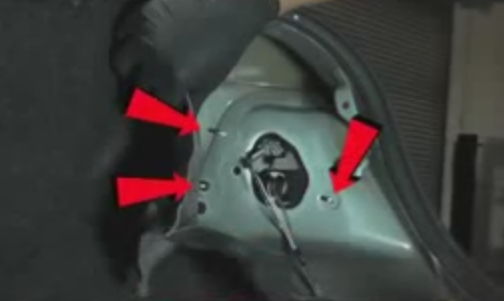
Obtaining a clear picture of the road situation at night is a priority task. Modern expensive cars are equipped with innovative LED units controlled by an entire intelligent complex. Owners of budget cars are still only given the opportunity to switch from halogen to xenon lighting sources.
We determine the difference between xenon and the less popular bi-xenon: design and visual features
A newbie in the automotive business, extremely dissatisfied with the standard headlights, will probably first try to improve the situation by simply replacing the light bulbs. Before choosing high-brightness lamps, you need to familiarize yourself with the corresponding class of lighting equipment, which is represented by Xenon and Bixenon.
The main visual difference between xenon and bi-xenon is their operating modes. Thus, a conventional Xe light source, without improving the design of the optics, can only operate in low-beam mode. The bi-xenon lamp also has the ability to illuminate objects in high beam mode.
Switching lighting modes in the Bixenon installation is carried out by changing the position of the luminous arc: the electrodes are located in a movable housing, which can move inside the bulb at the command of the electronics. The design of a conventional Xe monolamp involves rigid fixation of the electrodes inside the bulb, without giving them the opportunity to change position.
When considering the question “xenon or bi-xenon and which is better,” it is worth considering the design and visual differences of the lamps, as well as their compliance with certain types of headlights. Headlight units of modern cars are divided into two types :
- mono, in which lamps with a combined low and high beam are installed;
- separate, where each lighting mode has its own lamp.
Based on this, headlight lamps with two filaments can only be replaced with bi-xenon ones. Dual-mode xenon can also be installed in separate headlights.
Who is the favorite: xenon or bi-xenon and which is better to use?
The feasibility of installing bi-xenon lighting packages is questioned . Happy owners of super-bright light from Bixenon lamps, who have recently been content with halogen lighting, repeatedly note that in high beam mode the picture either did not change or worsened slightly.
This problem lies in the difference between the properties of bi-xenon and identical xenon and is additionally determined by the design of the headlight :
- xenon light, the spectrum of which approaches blue as the temperature increases, has a much higher frequency of wave oscillations than halogen yellow, and therefore is intensively scattered;
- double-filament halogen lamps are usually used without lenses and require an additional diffuser to fully illuminate the associated area;
- a xenon lamp, like a bi-xenon lamp installed in a Halogen class headlight, in low beam mode will dazzle oncoming drivers, while well illuminating the area in front;
- High-frequency high-range bi-xenon light in a conventional headlight will be intensively scattered, causing the low brightness of the spot located in front.
Despite the low efficiency of gas-discharge lamps, due primarily to the headlight configuration, many car enthusiasts believe that it is better to install xenon or bi-xenon rather than have a more dangerous dim light.
Experts, giving advice in this category, categorically do not recommend installing bi-xenon lamps due to their imperfect design.
Correct installation of xenon is not only less expensive, but also gives a positive effect (only possible with separate headlights!).
The correct method for installing xenon in a Halogen split-type headlight is as follows: a collecting lens is first installed and the headlight diffuser is polished to remove refractive elements (applies only to that part of the part that is responsible for the low beam).
If monoxenon lamps are installed , high lighting intensity is ensured by artificially focusing the light beam in one place. Oncoming drivers do not feel any discomfort. It is recommended to leave the high beam lamp halogen.
If the near and far are combined in one halogen lamp
mono-type headlights do not have to consider the negative differences between bi-xenon and xenon: the former are certainly considered the best. However, few people know that there is a very successful alternative to dual-action discharge lamps: bi-xenon lenses .
The upgraded optics has the following features :
- the lens works only with a conventional monoxenon lamp;
- the design of the lens provides for a “shutter” controlled by a button;
- the lens body has its own type of base;
- The device is mounted on the housing in which the halogen lamp base is located, using universal spacer rings.
Switching between near and far modes occurs instantly and without unnecessary flashes. The operation of gas-discharge lamps in such conditions guarantees the high efficiency of the lighting device, since the ray flux is collected by a lens that generates a luminous flux of a certain geometry.
Optimal properties: which bi-xenon has compromise characteristics and is better suited for night driving
Xenon or bi-xenon lamps are primarily divided by color temperature. For halogen light sources this figure is in the range of 3,000-3,200 K. The electric arc of a xenon lamp has a much higher temperature - 4,300 K and higher .
The answer to the question: “which bi-xenon is better and more pleasing to the eye”? — it is the color temperature that gives: the higher it is, the stronger the blue tint will predominate in the light spot.
The latter causes high tension in the visual organs, causing premature fatigue.
White light with a slight yellowish tint is considered optimal , which is demonstrated by xenon or bi-xenon headlights with a characteristic of 4,300-5,000 K.
An increase in temperature also negatively affects the quality of lighting: the higher the number in Kelvin, the more intense the light is scattered due to an increase in the oscillation frequency of the light wave.
In this case, the shape of the collecting lens may not cope with combining the rays into one light spot.
Installing an additional mask around the working part of the lens slightly improves the picture.
In the process of choosing what is better to install: xenon or bi-xenon, you should take into account the price and reputation of the company. The luminous arc in more expensive lamps does not deviate from the axis of the electrodes, demonstrating a consistently bright beam of light. Cheap analogues cannot boast of a static arc arrangement.
Conclusion
Dual-mode bi-xenon is a budget replacement for halogens with combined low and high beam.
Xenon is a lamp that operates in only one mode – low beam.
A high-quality alternative to bi-xenon lamps - bi-lenses + a regular Xe light source . Near/far adjustment is achieved by moving the shutter installed in the lens housing.
Source: http://autoclub.su/ksenon-ili-biksenon-chto-luchshe/
Xenon, BI-xenon, Lenses, Angel eyes
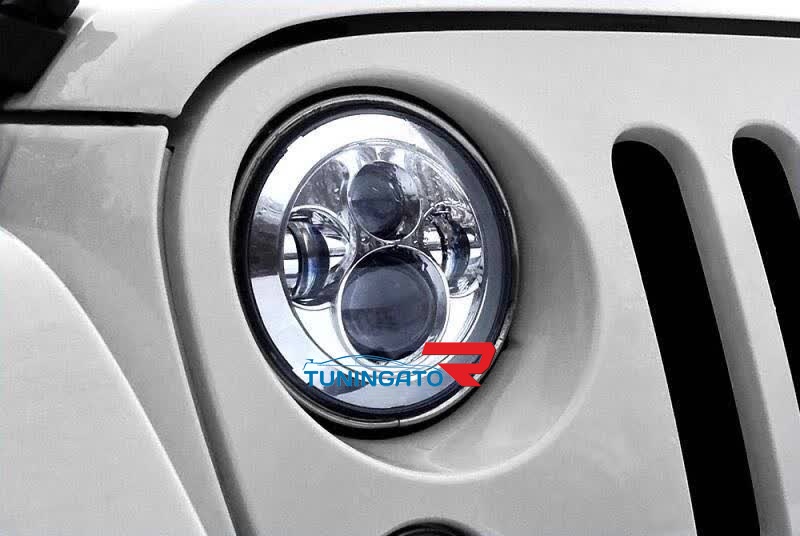
Installing xenon headlights is not a fad or a tribute to fashion. According to statistics, a modern person spends up to 15% of his life driving! Therefore, it is so important that the driver feels comfortable and safe in his car.
Car xenon headlights allow you to better illuminate the road even in bad weather (rain, fog), provide more light, which is also close to daylight and corresponds to our visual habits. By installing xenon, you will be less tired, and the driving process itself will begin to bring much more pleasure.
Of course, you have to pay for the right to scare away “dummies” from your path with the demanding blinking of cold blue “spotlights”. But, according to many car enthusiasts, installing xenon headlights is justified: it is better to spend money on good light than to get into an accident due to poor visibility on the road.
Why are sales of xenon headlights consistently growing? It's simple: xenon lamps are fundamentally new light sources that have many advantages over halogen lamps.
Our tuning center installs xenon, “Angel Eyes”, xenon and bi-xenon lenses in standard headlights of domestic and foreign cars.
Below are examples of the work of the masters of the tuning center //AMT.
Optical tuning for Nissan Qashqai.
The headlights were equipped with DXL 3″ lenses with Sho-Me 5000K xenon. The light has improved significantly, and the lenses fit very harmoniously into the headlights and look like they came from the factory!
Chevrolet Cruze optics tuning.
We installed Sho-Me 230 bi-xenon lenses with Sho-Me 4300K xenon. The inside of the headlights was painted matte black and a DRL strip + turn signal was installed.
Quad-xenon on Toyota Land Cruiser 200.
We installed two pairs of Dixel G5 mini 3.0″ bi-lenses and Sho-Me 4300K xenon, and installed bright MTF COB 4500K LEDs in the dimensions. We also painted the inside of the headlights matte black. Sho-Me diode lamps were chosen for the fog lights.
Infiniti M35x Installing CCFL angel eyes and painting the headlights inside matte black.
The owner's desire was simply to install angel eyes. But we decided to add to this the painting of the mask black, and we were right! The headlights began to look more aggressive and expressive!
Mitsubishi Eclipse 2G Many of us remember this car very well from the cult film Fast and the Furious, where the main character drove an acid-green Eclipse in deep tuning. And also based on the well-known and widely loved game NFS Underground.
And so, such a rather rare car for our city visited the pits of our tuning center. It was decided to start improvements with optics. It was no longer factory-made and the light from it was, frankly speaking, useless.
And here's what we did: – Installed two sets of Sho-Me 330 bi-xenon lenses – Xenon 5000K – Installed CCFL angel eyes
– Installed multi-color LED lens lighting. Glow modes are controlled from the remote control
Tuning Hyundai Solaris optics A week ago, our client had Sho-Me lenses with angel eyes installed. We also painted the headlight masks and lenses to match the color of the car, it turned out great! And we also installed flexible DRL strips from Sho-Me!
But the client came back to us and asked to install DRL strips in the PTF. We also painted the PTF reflectors black!
Tuning the optics of the Mitsubishi Lancer X.
The headlights are already lensed, we supplemented them with LED COB angel eyes, the masks were modified (we made slits on the side of the lens), a red LED backlight was installed in the slits and the lens (displayed on a separate button), the eyes are powered by the side lights. The masks were painted matte black.
Source: http://www.automoda-tuning.ru/tuning/58/ksenon-bi-ksenon-linzy-Angel-eyes.html
Angel Eyes - make your car noticeable!
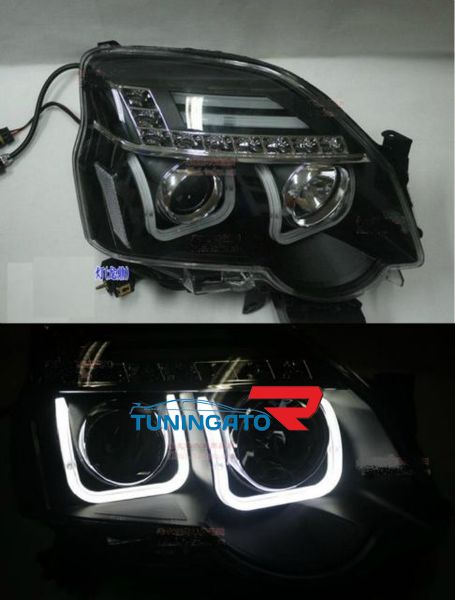
Car tuning is the easiest way to inexpensively distinguish your car from the gray crowd of faceless cars.
It’s clear that if you’re driving a sports car, then you don’t need anything else, you can immediately see that the car is expensive, the owner is the center of attention, honor and respect, the girls and life are good.
However, what about the owners of ordinary inexpensive cars of the “budget” class or even lower? How to stand out and attract attention? Here we can only recommend one thing - put “angel eyes” on your car and it will be simply gorgeous at night.
Not long ago I was driving past a nightclub at 2 am and not far from it there was a party of 4 cars, the subs were bombing. One car, a BMW, had its headlights turned off, and only the lights were on, and it was the lights that had angel eyes, and it looked simply killer - a kind of look from the darkness, as if a panther was looking at you. To be honest, I was impressed. The picture was something like this:
Let's take a closer look at the classification, what kind of “angel eyes” there are, how much they cost and other nuances such as which car can be installed on and what models of headlights.
So, first of all, it should be said that you can immediately buy a whole headlight assembled, diode tubes will already be built in there. However, this option is not cheap, the price will be several thousand, depending on the make of the car - for a Priora 3 thousand, and for some modern Mazda (up to at least the 6th model) it will cost about 5-7 thousand. Lensed optics, which includes AG, look great.
That’s why people are trying to make this kind of optics tuning cheaper and there are a lot of options.
LED “eyes” are the cheapest option, costing about 300 rubles per set.
It looks average, in my opinion, it’s better to install LED tubes - the edging of the “eyes” here will be continuous, without breaks, even and really more beautiful and cooler. However, it is also several times more expensive - from 1500 and above per pair. The cost is for 2 or even 4 pieces, here each store makes its own set, because the eyes can be double.
Video of BMW tuning, agree - it looks great
Next, the nuance is that the “eyes” can be solid or half-ringed. In my opinion, the half ring looks cooler, like the car is angry.
Size also matters - that is, diameter; on sale you can see from 60 to 120 or more mm. It all depends, of course, on the make of the car and your desire.
In the photo there are eyes using CCFL technology (solid tubes), isn’t it beautiful?
Initially, the Germans came up with this optics tuning and began installing them on BMW cars in order to further highlight the beauty and shape of the famous German optics. Therefore, if you have beha, then you will not have any problems with purchasing and choosing angel eyes. Many options, sizes for all car brands. And of course, it is better to have the purchased kits installed at a car repair shop.
It is important to understand that eyes are installed not only for beauty; in addition to looking cool, they serve as excellent side lights, or as they are also called, daytime running lights. In cloudy weather they are also clearly visible; they complement conventional headlights, so it turns out that they serve for the benefit of your safety.
What the law and traffic police say
The lights come in a variety of colors, so choose from red to green to suit your taste. However, this is fraught with attention from the traffic police, because not so long ago a law was passed prohibiting non-original xenon and other alterations in optics. As experienced people say, the most important thing, if you don’t want people to find fault, is not to bet red and blue. White and yellow will be fine.
I remember once, when I first bought a ten, it had dimensions made of blue diodes. So the Gaytsy stopped me and said - no way, comrade driver, they even began to scare me with deprivation of my license. To which I said that I would take them off today, and they let me go.
They argued that the blue color is a “mess” for their special signals and ordinary citizens do not have the right to drive like that. The next day I immediately installed white dimensions. So it’s better to put the “eyes” in a standard white color.
Why do you need to highlight and strain the traffic cops?
Bi-xenon and headlight painting
Also now the service of installing 5th generation bi-xenon lamps with already built-in angel eyes has become quite popular. Almost any car model, most often, of course, they are installed on sports sedans such as Mazda, Mitsubishi and, of course, BMW. What can I say, it looks simply awesome on VAZ 10, 12, 15 and 15, on Kalinas and Priors.
And by the way, another cool feature is that the headlights are painted in the color of the car, together with the eyes it looks even cooler, in the photo below the headlights are painted black and “eyes” are installed on a Honda CRV:
So if you decide to tune your car, then pay attention to this element of optics that makes you stand out from the crowd. Well, if you have a new generation BMW, then you simply have to install “angel eyes”, because it looks luxurious.
Photo
Of course BMW
Mazda 3
Toyota Corolla (old)
Chevrolet Lanos
Chic Lancer
Status Infinity
You might be interested in:
-
Everything you didn't know about xenon and bi-xenon
-
We choose a rear view camera complete with a display. Review of models from Neoline.
Source: http://gps-navigator-info.ru/optika/angel-skie-glazki-sdelaj-svoe-avto-zametny-m/


